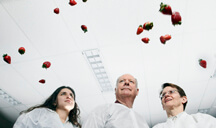Low-maintenance strawberry may be good crop to grow in space

Purdue's Gioia Massa, from left, Cary Mitchell and Judith Santini found that a particular type of strawberry seems to meet NASA guidelines for foods that could be grown in space. (Purdue Agricultural Communication photo/Tom Campbell)
WEST LAFAYETTE, Ind. - Astronauts could one day tend their own crops on long space missions, and Purdue University researchers have found a healthy candidate to help satisfy a sweet tooth - a strawberry that requires little maintenance and energy.
Cary Mitchell, professor of horticulture, and Gioia Massa, a horticulture research scientist, tested several cultivars of strawberries and found one variety, named Seascape, which seems to meet the requirements for becoming a space crop.
"What we're trying to do is grow our plants and minimize all of our inputs," Massa said. "We can grow these strawberries under shorter photoperiods than we thought and still get pretty much the same amount of yield."
Seascape strawberries are day-neutral, meaning they aren't sensitive to the length of available daylight to flower. Seascape was tested with as much as 20 hours of daylight and as little as 10 hours. While there were fewer strawberries with less light, each berry was larger and the volume of the yields was statistically the same.
"I was astounded that even with a day-neutral cultivar we were able to get basically the same amount of fruit with half the light," Mitchell said.
The findings, which were reported online early in the journal Advances in Space Research, showed that the Seascape strawberry cultivar is a good candidate for a space crop because it meets several guidelines set by NASA. Strawberry plants are relatively small, meeting mass and volume restrictions. Since Seascape provides fewer, but larger, berries under short days, there is less labor required of crew members who would have to pollinate and harvest the plants by hand. Needing less light cuts down energy requirements not only for lamps, but also for systems that would have to remove heat created by those lights.
"We're trying to think of the whole system -- growing food, preparing it and getting rid of the waste," Massa said. "Strawberries are easy to prepare and there's little waste."
Seascape also had less cycling, meaning it steadily supplied fruit throughout the test period. Massa said the plants kept producing fruit for about six months after starting to flower.
Mitchell said the earliest space crops will likely be part of a "salad machine," a small growth unit that will provide fresh produce that can supplement traditional space meals. Crops being considered include lettuces, radishes and tomatoes. Strawberries may be the only sweet fruit being considered, he said.
"The idea is to supplement the human diet with something people can look forward to," Mitchell said. "Fresh berries can certainly do that."
Judith Santini, a research statistical analyst in Purdue's Department of Agronomy, was responsible for data analysis from the tests.
Mitchell and Massa said they next plan to test Seascape strawberries using LED lighting, hydroponics and different temperature ranges. NASA funded their work.
Writer: Brian Wallheimer, 765-496-2050, bwallhei@purdue.edu
Sources: Cary Mitchell, 765-494-1347, cmitchell@purdue.edu
Gioia Massa, 765-496-2124, gmassa@purdue.edu
Judith Santini, 765-494-6663, jsantini@purdue.edu
Ag Communications: (765) 494-8415;
Steve Leer, sleer@purdue.edu
Agriculture News Page
ABSTRACT
Minimizing Energy Utilization for Growing Strawberries
During Long-Duration Space Habitation
Gioia D. Massa, Judith B. Santini and Cary A. Mitchell
Strawberry is a candidate crop for space that is rich in protective antioxidants and could also have psychological benefits as a component of crew diets during long-duration space habitation. Energy for electric lighting is a major input to a controlled-environment crop-production system for space habitation. Day-neutral strawberry cultivars were evaluated at several different photoperiods to determine minimum lighting requirements without limiting yield or negatively impacting fruit quality. The cultivars 'Tribute', 'Seascape', and 'Fern' were grown at 14, 17, or 20 h of light per day, and fruit yield was evaluated over a 31-week production period. This amounted to a difference of 2418 kWh m−2 in energy usage between the longest and shortest photoperiods. All cultivars produced similar total fresh weight of fruit regardless of photoperiod. Volunteer tasters rated organoleptic characteristics including sweetness, tartness, texture, and overall appeal as measures of fruit quality. Generally, organoleptic attributes were not affected by photoperiod, but these attributes were somewhat dependent upon cultivar and harvest time. Cultivars under different photoperiods varied in their production of fruit over time. 'Seascape' was the most consistent producer, typically with the largest, most palatable fruit. 'Seascape' plants subsequently were grown at 10-, 12-, or 14-h photoperiods over a treatment period of 33 weeks. Photoperiod again had no significant effect on total fruit weight, although there were periodic flushes of productivity. Fruit under all photoperiods had acceptable approval ratings. A large-fruited, day-neutral strawberry cultivar such as 'Seascape' remains productive under shortened photoperiods, allowing reductions in energy and crew labor while maintaining flexibility for mixed-cropping scenarios in space.
